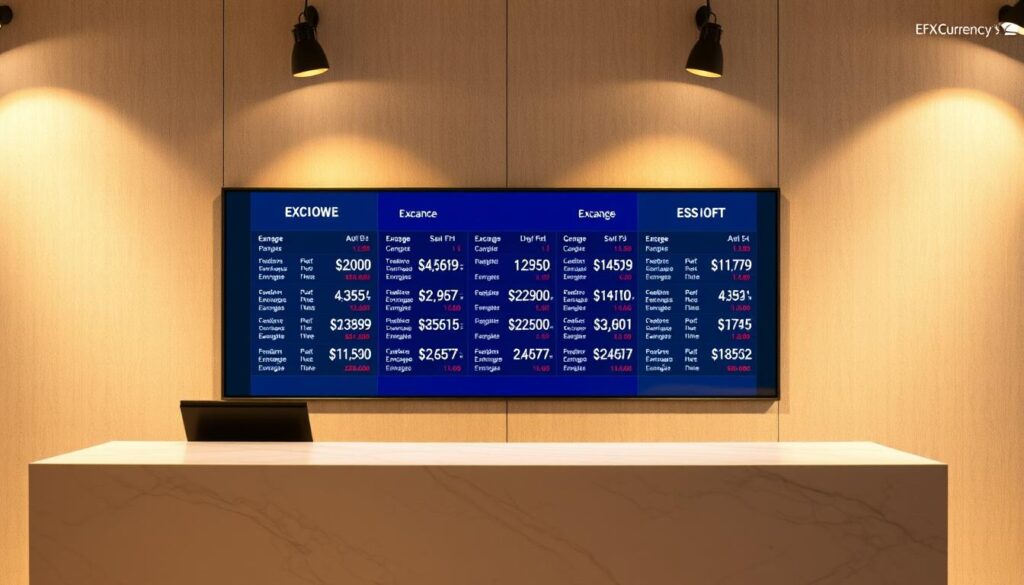Investors today face a critical choice: where to allocate funds in fast-paced global markets. Traditional foreign exchange and emerging digital asset platforms offer distinct opportunities. This guide explores their differences, helping traders navigate these dynamic spaces.
The forex market operates 24/5, focusing on currency pairs like EUR/USD. It thrives on high liquidity and established regulations. Meanwhile, crypto markets trade blockchain-based assets such as Bitcoin, often with decentralized structures and round-the-clock access.
Key factors separate these approaches. Market size, volatility patterns, and participant types vary significantly. Traditional trading platforms use leverage and margin differently than crypto exchanges. Even basic mechanics like order execution differ between these ecosystems.
This analysis draws from verified financial data to compare:
- Regulatory frameworks shaping each market
- Risk management strategies for volatility
- Technology’s role in execution speed
Understanding these elements helps traders make informed decisions. Whether prioritizing stability or innovation, this guide provides actionable insights for modern portfolio strategies.
Understanding the Basics of Forex Trading
Global financial markets offer diverse opportunities, with currency trading standing out as a cornerstone for traders. This market operates five days a week, connecting institutions and individuals through regulated platforms. At its core, transactions involve currency pairs like EUR/USD, where values fluctuate based on supply and demand.
Currency Pairs and Trading Mechanics
Every trade involves two currencies: one bought, another sold. Major pairs like GBP/USD dominate the market, with price movements measured in pips. For example, a 0.0001 shift in EUR/USD equals one pip. Standard lots represent 100,000 units, though fractional lots allow smaller positions.
Leverage and Economic Influences
Brokers often provide leverage, amplifying buying power through margin deposits. A 1:50 ratio lets traders control £50,000 with £1,000 capital. However, this magnifies both gains and losses. Key economic reports – interest rates, GDP data, and employment figures – drive price changes. Geopolitical events like elections also create volatility.
The UK’s Financial Conduct Authority oversees this structured environment, ensuring transparency. Traders monitor the Bank of England’s decisions closely, as pound sterling remains among the most traded currencies globally.
Unpacking Crypto Trading Fundamentals

Modern finance witnesses a paradigm shift with decentralized systems reshaping asset exchange. Unlike traditional frameworks, these markets operate 24/7 through distributed networks, enabling instant global transactions. Central to this evolution is blockchain technology, which records every trade on immutable ledgers visible to all participants.
Blockchain Technology and Digital Wallets
Blockchain’s decentralized structure eliminates intermediaries, allowing direct peer-to-peer transfers. Each transaction gets verified by network nodes, creating tamper-proof records. Digital wallets serve as gateways to this ecosystem, storing private keys that control asset access.
Security remains critical for wallet users. Hardware devices offer offline storage, while software versions prioritize convenience. Multi-signature setups and two-factor authentication add layers of protection against unauthorized access.
Popular Cryptocurrencies and Stablecoins
Bitcoin pioneered decentralized value transfer, with Ethereum expanding possibilities through smart contracts. These coins often experience significant price swings, attracting speculative interest.
Stablecoins like Tether (USDT) bridge volatility gaps by pegging values to fiat currencies. They enable seamless transitions between volatile assets and stable holdings. Both institutional players and individual traders now participate actively, drawn by market accessibility and innovation potential.
Forex vs Crypto: Comparing Market Size, Volatility, and Accessibility

Financial landscapes present two dominant arenas for asset exchange. Traditional currency markets process over $6 trillion daily, dwarfing digital asset platforms’ $200 billion average. This disparity highlights contrasting liquidity levels and institutional involvement.
Operational Hours and Participant Profiles
Major banks and hedge funds dominate currency transactions, executing large orders through regulated channels. Retail involvement grows steadily, but institutions control price movements. Digital asset platforms attract individual enthusiasts and tech-savvy investors, with 78% of activity coming from non-professional participants.
Volatility separates these ecosystems sharply. Major currency pairs typically fluctuate 0.5-1% daily, while leading digital assets often swing 5-10%. Bitcoin’s 20% single-day drops contrast sharply with the pound’s rare 2% shifts.
- Accessibility: Digital platforms require only internet access, while currency trading often demands larger capital
- Regulatory oversight: FCA-regulated brokers dominate pound trading, whereas digital exchanges operate under varied jurisdictions
- Market hours: Currency markets close weekends; digital assets trade continuously
Entry barriers differ significantly. Currency traders face strict verification processes, while digital platforms enable anonymous accounts in some regions. However, heightened security risks accompany this ease of access in blockchain-based systems.
Exploring Market Characteristics and Risk Profiles

Market dynamics shape trading outcomes through liquidity and price behavior. High-traffic environments reduce transaction costs, while fragmented markets amplify unpredictability. These factors directly influence profit potential and exposure.
Liquidity and Trading Costs in Each Market
Currency markets process trillions daily, creating razor-thin spreads. Major pairs like EUR/USD often have 0.1-pip differences between buy/sell prices. This efficiency lets traders enter/exit positions with minimal slippage.
Digital asset platforms face liquidity challenges during off-peak hours. A $50,000 Bitcoin order might move prices 2% in thin markets. Such conditions increase transaction costs and execution risks for large trades.
Leveraged Trading and Volatility Concerns
Brokers offer 1:30 leverage on pound-dollar trades, turning £3,000 into £90,000 exposure. While this magnifies gains, a 1% drop erases £900 capital. Margin calls occur faster during sudden price movements.
Digital assets regularly swing 15% within hours. Ethereum’s 30% plunge last March trapped over-leveraged positions. Unlike regulated currency markets, these platforms lack standardized circuit breakers to halt extreme volatility.
Strategic traders adjust position sizes based on market conditions. Currency specialists might risk 2% per trade, while digital asset investors often halve that threshold. Understanding these risk profiles helps balance opportunity and exposure.
Regulation, Security, and Broker Considerations
Navigating financial markets demands awareness of safeguards protecting capital and ensuring fair practices. Regulatory oversight and security protocols vary widely between traditional and digital asset platforms, directly impacting investor protections.
Regulatory Frameworks in the United Kingdom
The UK’s Financial Conduct Authority (FCA) enforces strict rules for currency brokers. Licensed firms must segregate client funds, publish transparent pricing, and undergo regular audits. These measures reduce risks like misappropriation of assets or fraudulent activities.
Digital asset platforms face fragmented oversight. While the EU’s MiCA framework aims to standardize crypto rules by 2024, UK regulations remain in development. Many exchanges operate without mandatory licensing, increasing exposure to losses from insolvencies or market manipulation.
Security Measures and Risk Mitigation Strategies
Reputable brokers employ advanced encryption and two-factor authentication to secure accounts. The FCA requires compensation schemes covering up to £85,000 per client if firms collapse. Digital platforms often use cold storage wallets, keeping 90% of assets offline to deter hackers.
Key strategies for managing risk include:
- Setting stop-loss orders to limit potential losses
- Diversifying across multiple assets and platforms
- Verifying exchange security certifications like ISO 27001
Recent incidents highlight vulnerabilities. A 2023 breach at a major digital exchange resulted in $35 million stolen, while regulated currency brokers reported zero client fund thefts. Traders must balance convenience with robust safeguards when choosing platforms.
Profitability Factors: Opportunities and Challenges

Achieving sustainable returns requires balancing market opportunities with operational realities. Both currency markets and digital asset platforms present unique pathways to profits, each demanding tailored strategies.
Potential Returns and Leverage Implications
Currency markets enable steady gains through strategic positioning. A trader using 1:30 leverage could turn a 0.5% EUR/GBP movement into 15% returns. This approach works in bullish and bearish conditions, offering consistent profit potential for disciplined investors.
Digital assets showcase different dynamics. Bitcoin surged 150% in early 2023 before losing 40% within weeks. Such wild fluctuations create high-reward scenarios but demand precise timing. Few markets move 10% daily like Ethereum during major protocol upgrades.
Three critical considerations shape profitability:
- Market timing: Currency traders exploit economic cycles, while digital asset investors chase technological breakthroughs
- Position sizing: Leverage amplifies both gains and losses across markets
- Risk buffers: Maintaining 50% equity cushions prevents margin calls during volatility spikes
Individuals must assess their risk tolerance. Currency markets suit those seeking gradual value growth, while digital platforms attract capital willing to withstand dramatic price swings. Successful investors combine technical analysis with strict exit strategies to lock in profits.
Trading Mechanics and Strategies for Success

Mastering market movements requires understanding core execution principles. Traders analyze price patterns while monitoring economic shifts, blending technical precision with real-world context. This dual approach helps identify high-probability entry points across different asset classes.
Technical Analysis and Fundamental Insights
Candlestick patterns and moving averages reveal hidden trends. A bullish engulfing pattern at key support often signals reversal opportunities. Simultaneously, interest rate decisions can override technical setups – savvy traders balance both perspectives.
Project upgrades in blockchain networks frequently trigger price surges before public announcements. Monitoring developer activity provides early signals, while CPI reports sway currency valuations. Successful investors cross-reference these elements to time transactions effectively.
Effective Risk Management Techniques
Stop-loss orders protect capital during sudden volatility. A 2% account risk limit per trade prevents emotional decisions. Traders often set take-profit levels at 1:3 risk-reward ratios, locking gains before markets reverse.
Position sizing adapts to liquidity conditions. Thin markets require smaller allocations to avoid slippage. Demo accounts let beginners test strategies without financial exposure, refining their approach over time.
Seasoned professionals track transaction costs closely. They split large orders into chunks during peak liquidity hours, minimizing market impact. This disciplined execution separates consistent performers from occasional gamblers.
Why Choose Forex or Crypto? Considerations for Beginners

New traders entering financial markets often grapple with platform selection. Both traditional and digital asset spaces provide distinct pathways, each requiring tailored preparation strategies. Success hinges on aligning educational access, capital availability, and personal risk tolerance.
Skill Development Through Practice Tools
Established currency platforms offer extensive learning materials. Many brokers provide free demo accounts simulating real-market conditions. Users practice executing trades with major pairs like GBP/USD without financial risk. Webinars and eBooks explain fundamental analysis techniques used by professional investors.
Digital asset exchanges focus on intuitive interfaces rather than structured courses. Beginners can access video tutorials explaining wallet setups and blockchain mechanics. However, fewer resources address advanced cryptocurrency trading strategies compared to traditional markets.
Financial Commitments and Entry Processes
Currency trading often demands higher initial deposits. Many UK brokers require £100-500 minimums for live accounts. In contrast, popular crypto platforms allow purchases starting at £10. This lower barrier attracts retail participants seeking flexible investment options.
Three steps streamline market entry:
- Select FCA-regulated brokers or reputable digital exchanges
- Complete identity verification (required for currency platforms)
- Start with small positions using risk management tools
Understanding order types and market hours proves crucial. Currency traders must track economic calendars, while digital asset investors monitor blockchain network updates. Both markets reward those who master technical analysis before committing significant capital.
Final decisions should reflect personal goals. Those valuing structured learning might prefer traditional platforms. Tech-savvy retail traders often gravitate toward cryptocurrency for its 24/7 access and innovation potential. Regardless of choice, gradual exposure through educational resources reduces early-career missteps.
Final Thoughts on Navigating Dynamic Financial Markets
Modern traders operate in an era where traditional currencies and digital assets coexist as viable investment channels. While currency markets provide stability through established regulations, blockchain-based platforms offer innovative opportunities with higher volatility. Understanding these distinctions helps investors allocate money strategically across both ecosystems.
Key differences lie in market structure and oversight. Traditional exchanges process trillions daily under strict frameworks, while digital assets trade continuously with evolving governance. Price swings in digital markets often exceed 10% daily, demanding robust risk management strategies.
Three principles guide success across both domains:
- Adapt strategies to shifting regulatory landscapes
- Leverage technology for real-time price analysis
- Balance portfolios based on personal risk thresholds
Continuous learning remains essential. Traders should monitor central bank policies for currency positions and blockchain updates for digital assets. Combining steady returns from major currencies with selective crypto opportunities creates diversified exposure.
Ultimately, aligning decisions with long-term goals ensures sustainable growth. Whether prioritizing liquidity or innovation, informed choices drive profitability in these interconnected yet distinct financial arenas.



